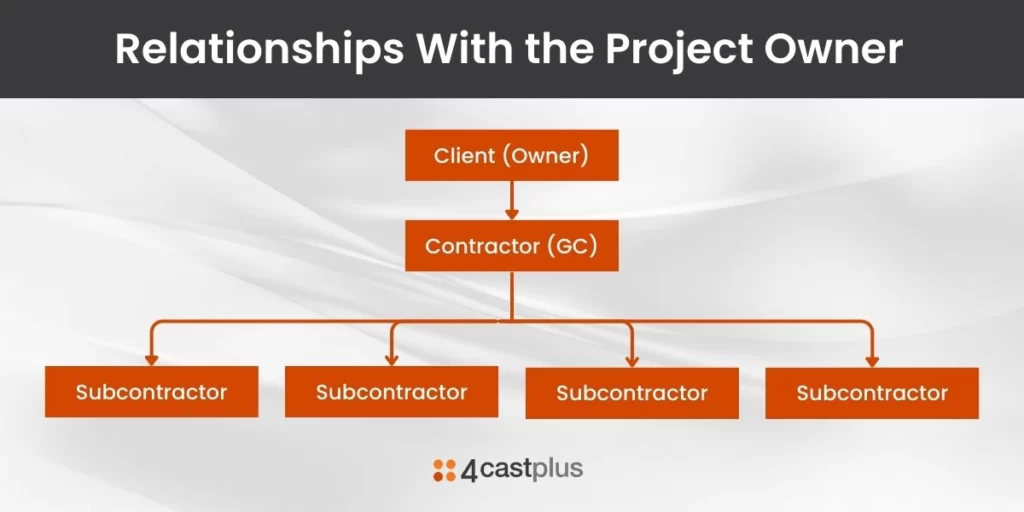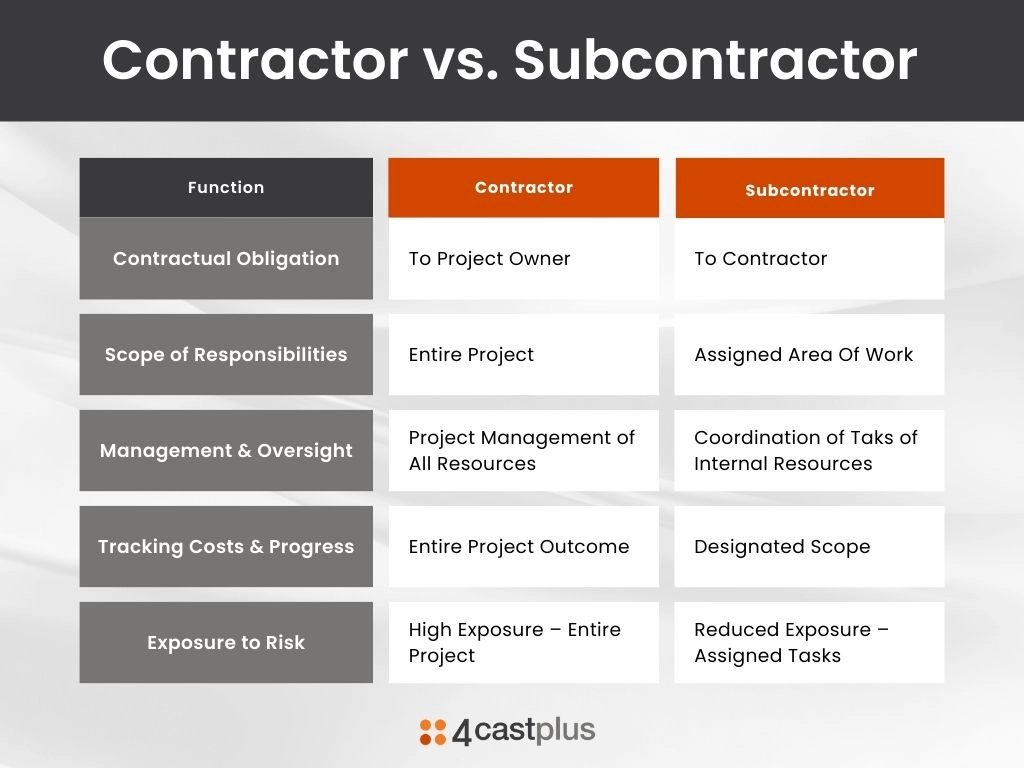Read In 12 Minutes
Even seasoned construction pros will admit a job site can be chaotic with people and machinery moving in all directions. Although the dynamic pace may seem random and haphazard, underlying the appearance of disorder, is a virtual symphony of planning and execution. Understanding the roles and responsibilities of some key players involved can help shed light on the order within the chaos.
While many stakeholders contribute to a construction project’s execution, two are at the forefront of a project’s successful completion. These are contractors and subcontractors and are the main players on the job site. The terms sound nearly the same so are often mischaracterized as indistinguishable, but their roles are very different and necessary to keep the music playing on any size or type of job. Following is a high-level description of the purposes of each, along with their key differences.

Contractors
The contractor is often referred to as the general contractor, or GC. They lead the project as the primary representative of the ‘owner’ and are ultimately responsible for its completion. The contractor has a direct relationship with the project’s owner, who is the stakeholder funding the project. Although some contractors will perform some of the work, many GCs will exclusively execute in the role of the coordinating manager that oversees the good governance and successful completion of the project. They are obligated to the owner to construct the project within the owner’s budget and timeframe; which they will do according to the proposal they delivered to the client (owner) during the initial bidding process.
It’s worth noting that sometimes large and complex projects are split into multiple phases or areas. In this situation, separate contracts are issued to different contractors for each area. By splitting the large complex project into smaller pieces, owners can manage the risk of any one contractor becoming incapable of completing their area. The impact of this one failure is minimized compared to if they had been responsible for the entire project. This strategy of risk mitigation is discussed in the article, “10 Project Risks Facing Contractors & Business Owners”.

Contractors: Get Connected With 4castplus
Subcontractors
While the contractor may perform some of the tasks needed to build a project, their main role is to focus on project management. Of course, the building of anything no matter how simple or complex requires specialists in certain trades to perform the specialized work. And that’s where the subcontractor enters the picture. The subcontractors employ trades people such as Surveyors, Equipment Operators, Concrete Finishers, Electricians, Pipe Fitters, Welders, Carpenters, and on and on. The companies that perform these specialized duties are referred to as subcontractors. When they are hired, they will enter into an agreement with the contractor in the form of a contract outlining the work they will perform and the schedule for which it is to be completed. Their exposure to risk is minimal provided they complete the work they have been asked to perform, and complete it according to the agreed terms of the contract.
Once hired, they focus only on their area and must coordinate their work with the contractor and other subcontractors as they work alongside one another. Although subcontractors can be small, one-person organizations, they can also be very large, multi-discipline organizations with thousands of employees.

Key Differences Between the Two
The difference between a contractor and subcontractor is not directly related to the company itself since larger, multi-disciplinary companies can operate as a GC on one project and as a subcontractor on another project. The main difference is in the role they’re playing on the project itself. That role has not only a contractual (legal) context; but also a functional context as well as a communications & public relations context. When driving by a construction site, for example, it’s often the case that the general contractor will have its logo splashed across signs & banners around the site – clearly indicating that they are the public face of the project.
Although there are many key elements that differentiate the two, we’ve highlighted three key differences as:
- Relationship with the Project Owner
- Jobsite responsibilities
- Management and oversight
1. Relationship with the Project Owner
The contractor will be selected by the project owner because they presented the best proposal to deliver the project. Once in place, all communication with the owner will then go through the contractor as they provide regular updates about the overall progress of the project, and address questions and concerns the owner may identify. The contractor will have a process to verify that work is complete to the owner’s standard and gain approval to change or expand the scope if it becomes necessary.
The contractor will evaluate proposals from several possible subcontractors for the areas of work that need to be completed and select the company that can offer the level of quality and price that best supports their plans on delivering the project. The subcontractor then reports to the general contractor and submits all necessary documentation, completed deliverables, and their invoices to them. Usually, the subcontractor will have no formal interaction with the project owner aside from when the contractor may require them to provide their expert input into a discussion directly with the owner.

2. Jobsite Responsibilities
The contractor is responsible to take all necessary steps to build the project. This may include seeking permits and approvals for certain activities on the site as well as maintaining positive relations with all parties involved with or affected by the project. For example, if a portion of the work being performed on the project is particularly disruptive to the surrounding community, the contractor will take the necessary steps to ensure affected parties are prepared for the disruption. They are ultimately responsible to establish work site safety standards, security, and ensure all payments are made on time. As you can imagine, as a project is carried out, a great deal of money is required to pay labor and equipment resources as well as buy all the materials required. While a contractor may be able to fund initial start-up costs of the project, they must ensure work is progressing so they too can submit invoices and maintain a positive cash flow. Anything that happens on the jobsite falls under the contractor’s umbrella. On the other hand, the subcontractor, being only responsible for their assigned area of work, are thus subject to less risk than the contractor. That’s not to say the subcontractor can’t experience adverse conditions during the job, but they only will be responsible for problems originating within their work area.
3. Management and Oversight
When initially preparing their proposal, the contractor will have conducted a detailed estimate to determine the time and resources required to build the project. They will enter a planning phase where a detailed schedule will be constructed outlining the start and end dates of each task required to build the project. This detailed task list is known as a work breakdown structure (WBS). The contractor will assign work and monitor the progress of the project by comparing progress on the project against what was planned. Successful contractors have automated this planning process and will utilize an enterprise project control and cost management system to keep all the costs and hours organized while easily preparing progress reports and billings. This automation assists them in overseeing all aspects of projects no matter how simple or complex. Each work activity can be analyzed to determine if work is progressing according to the planed schedule, if there are areas that are falling behind schedule and how labor, equipment, subcontract, and material costs measure up to the planned budget.
Cash flow can also be monitored to ensure everyone is paid and they have met their obligations so they can in turn be paid by the project owner. The subcontractor will also have a system to monitor their work in the very same way as the contractor. Consistent with differences already noted, they will instead focus only on their area of work. Their schedule will be less complex than the contractor as they are only looking at their own timeline. They still need to monitor progress and incurred costs to ensure they are successful in completing their portion of the work. Ultimately the subcontractor’s level of management and oversight is minimal compared to the contractor.

Learn More
4castplus has been specifically designed to manage the heavy demands of construction projects. With powerful features and intelligent workflows, your teams will have greater visibility and control. Let 4castplus streamline the execution of your key projects and move your organization to the next level Contact us to learn more.
 Platform
Platform Solutions
Solutions Owners
Owners Contractors
Contractors Engineering/EPCM
Engineering/EPCM Professional Services
Professional Services Resources
Resources White Papers
White Papers Case Studies
Case Studies Blog
Blog Videos
Videos Frequently Asked Questions
Frequently Asked Questions Company
Company About
About

